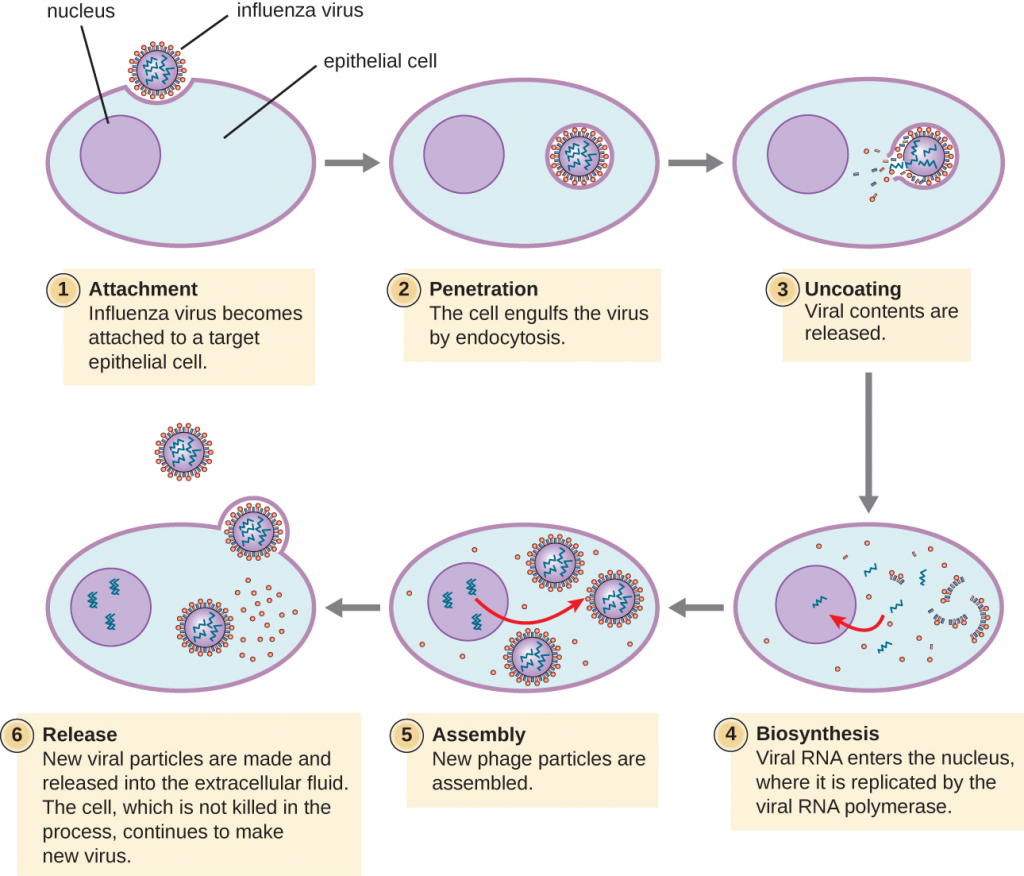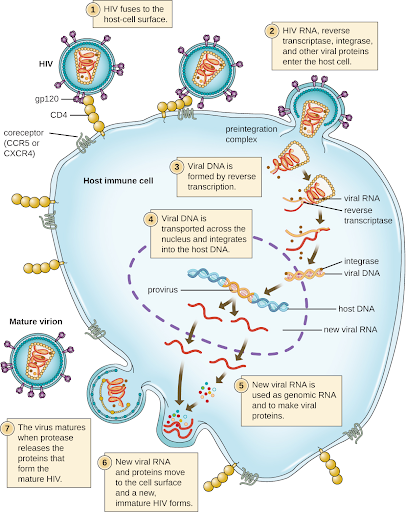3.14 Antivirals
Open Resources for Nursing (Open RN)

Unlike the complex structure of fungi or protozoa, viral structure is simple. There are several subclasses of antiviral medications: antiherpes, antiinfluenza, anti-hepatitis, and antiretrovirals. Each subclass will be discussed in more detail below. See Figure 3.10[1] for images of viruses.
Subclass: Antiherpes
Indications: Acyclovir (Zovirax) and its derivatives are frequently used for the treatment of herpes and varicella virus infections, including genital herpes, chickenpox, shingles, Epstein-Barr virus infections, and cytomegalovirus infections.
Mechanism of Action: Acyclovir causes termination of the DNA chain during the viral replication process. Acyclovir can be administered either topically or systemically, depending on the infection.[2]
Special Administration Considerations: Acyclovir use may result in nephrotoxicity.
Patient Teaching & Education: Patients who are being treated with antiviral therapy should be instructed about the importance of medication compliance. They may also experience significant fatigue, so periods of rest should be encouraged.[3]
Subclass: AntiInfluenza
Indications: Tamiflu (oseltamivir) is used to target the influenza virus by blocking the release of the virus from the infected cells.
Mechanism of Action: Tamiflu prevents the release of virus from infected cells.
Special Administration Considerations: This medication does not cure influenza, but can decrease flu symptoms and shorten the duration of illness if taken in a timely manner. Patients are prescribed the medication for prophylaxis against infection, known exposure, or to lesson the course of the illness. If patients experience flu-like symptoms, it is critical that they start treatment within 48 hours of symptom onset.
Patient Teaching & Education: Patients who are being treated with antiviral therapy should be instructed about the importance of medication compliance. They may also experience significant fatigue, so periods of rest should be encouraged.[4]
The influenza virus is one of the few RNA viruses that replicates in the nucleus of cells. Antivirals block the release stage. See Figure 3.11.[5]

Subclass: Antiretrovirals
Viruses with complex life cycles, such as HIV, can be more difficult to treat. These types of viruses require the use of antiretroviral medications that block viral replication. (See Figure 3.12 to view the viral replication process of HIV.) [6] Additionally, antiretrovirals fall under the class of antiviral medications.

Indications: Antiretrovirals are used for the treatment of illnesses like HIV.
Mechanism of Action: Antiretrovirals impede virus replication.
Special Administration Considerations: Many antiretrovirals may impact renal function; therefore, the patient’s urine output and renal labs should be monitored carefully for signs of decreased function.
Patient Teaching & Education: Patients who are being treated with antiviral therapy should be instructed about the importance of antiretroviral compliance. They may also experience significant fatigue, so periods of rest should be encouraged.[7]
Now let’s take a closer look at the medication grids for the subclasses of antivirals in Table 3.14a-d.[8]
Tables 3.14a Acyclovir Medication Grid
| Class/Subclass | Prototype/
Generic |
Administration Considerations | Therapeutic Effects | Side/Adverse Effects |
|---|---|---|---|---|
| Antivirals: Antiherpes | acyclovir | Check for allergies
Route: PO, IV, or topical; do not give IM or subcutaneously (subq) Give with food if GI distress IV: Give IV infusion over at least 1 hour to prevent renal tubular damage Use cautiously if renal impairment, neurological problems, or dehydration Start therapy as early as possible after signs or symptoms occur Encourage fluid intake Avoid sexual contact while lesions present |
Drug is not a cure for herpes but improves signs and symptoms of herpes lesions if started early
Can be used long term for prevention of outbreaks |
GI distress
Monitor renal function in long-term use, especially if renal impairment Lowers seizure threshold |
Tables 3.14b Oseltamivir Medication Grid
| Class/Subclass | Prototype/
Generic |
Administration Considerations | Therapeutic Effects | Side/Adverse Effects |
|---|---|---|---|---|
| Antivirals:
AntiInfluenza Agents |
oseltamivir | Check for allergies
Route: PO Must be given within 48 hours of onset of symptoms Administer with food to avoid GI distress Does not replace need for annual influenza vaccination |
Reduce duration of flu symptoms | GI distress
Serious skin/ hypersensitivity reactions; discontinue immediately Monitor for neuropsychiatric symptoms Use cautiously in patients with renal failure, chronic cardiac or respiratory diseases, or any medical condition that may require imminent hospitalization |
Tables 3.14c Adefovir Medication Grid
| Class/Subclass | Prototype/
Generic |
Administration Considerations | Therapeutic Effects | Side/Adverse Effects |
|---|---|---|---|---|
| Antivirals:
Anti-Hepatitis Agents |
adefovir | Route: PO
Prolonged therapy (>1 year or indefinitely) based on patient status Offer HIV testing; may promote resistance to antiretrovirals in patients with chronic HBV infection who also have unrecognized or untreated HIV infection Do not stop taking medication unless directed. Monitor hepatic function several months after stopping therapy |
Maintain or improve liver function when active disease is present | Severe acute exacerbations of Hepatitis B
Nephrotoxicity Lactic acidosis Severe hepatomegally |
Tables 3.14d Lamuvadine-Zidovudine Medication Grid
| Class/Subclass | Prototype/
Generic |
Administration Considerations | Therapeutic Effects | Side/Adverse Effects |
|---|---|---|---|---|
| Antivirals:
Antiretrovirals Nucleoside– nucleotide reverse transcriptase inhibitors |
lamivudine- zidovudine | Check for allergies
Lamivudine used to treat HIV-1 infection contains a higher dose of the active ingredient than the lamivudine used to treat chronic HBV infection. Patients with HIV-1 infection should receive only dosing forms appropriate for HIV-1 treatment Use cautiously in patients with renal impairment Inform patient that drug doesn’t cure HIV infection, that opportunistic infections and other complications of HIV infection may still occur, and that transmission of HIV to others through sexual contact or blood contamination is still possible. Taking these medications, along with practicing safer sex and making other lifestyle changes, may decrease the risk of transmitting (spreading) the HIV or hepatitis B virus to other people Teach symptoms of pancreatitis |
Decreases chance of developing acquired immunodeficiency syndrome (AIDS) and HIV-related illnesses such as serious infections or cancer | Lactic acidosis
Severe hepatomegaly Stop treatment immediately if pancreatititis |
Critical Thinking Activity 3.14a
Using the above grid information, consider the following clinical scenario question:
A patient is prescribed oseltamivir (Tamiflu) for influenza symptoms. The patient states to the nurse, “I hope this medication works quickly! I have felt lousy for the past 5 days!” What is the nurse’s next best response?
Note: Answers to the Critical Thinking activities can be found in the “Answer Key” sections at the end of the book.
- "Unknown" by CNX OpenStax is licensed under CC BY 4.0 Access for free at https://openstax.org/books/microbiology/pages/1-3-types-of-microorganisms ↵
- This work is a derivative of Microbiology by OpenStax licensed under CC BY 4.0. Access for free at https://openstax.org/books/microbiology/pages/1-introduction ↵
- uCentral from Unbound Medicine. https://www.unboundmedicine.com/ucentral ↵
- uCentral from Unbound Medicine. https://www.unboundmedicine.com/ucentral ↵
- "Unknown" by CNX OpenStax is licensed under CC BY 4.0 Access for free at https://openstax.org/books/microbiology/pages/6-2-the-viral-life-cycle ↵
- This work is a derivative of "HIV Virus Replication Cycle" by NIAID is licensed under CC BY 2.0 ↵
- uCentral from Unbound Medicine. https://www.unboundmedicine.com/ucentral ↵
- Daily Med, https://dailymed.nlm.nih.gov/dailymed/index.cfm, used for hyperlinked medications in this module. Retrieved June 27, 2019 ↵

